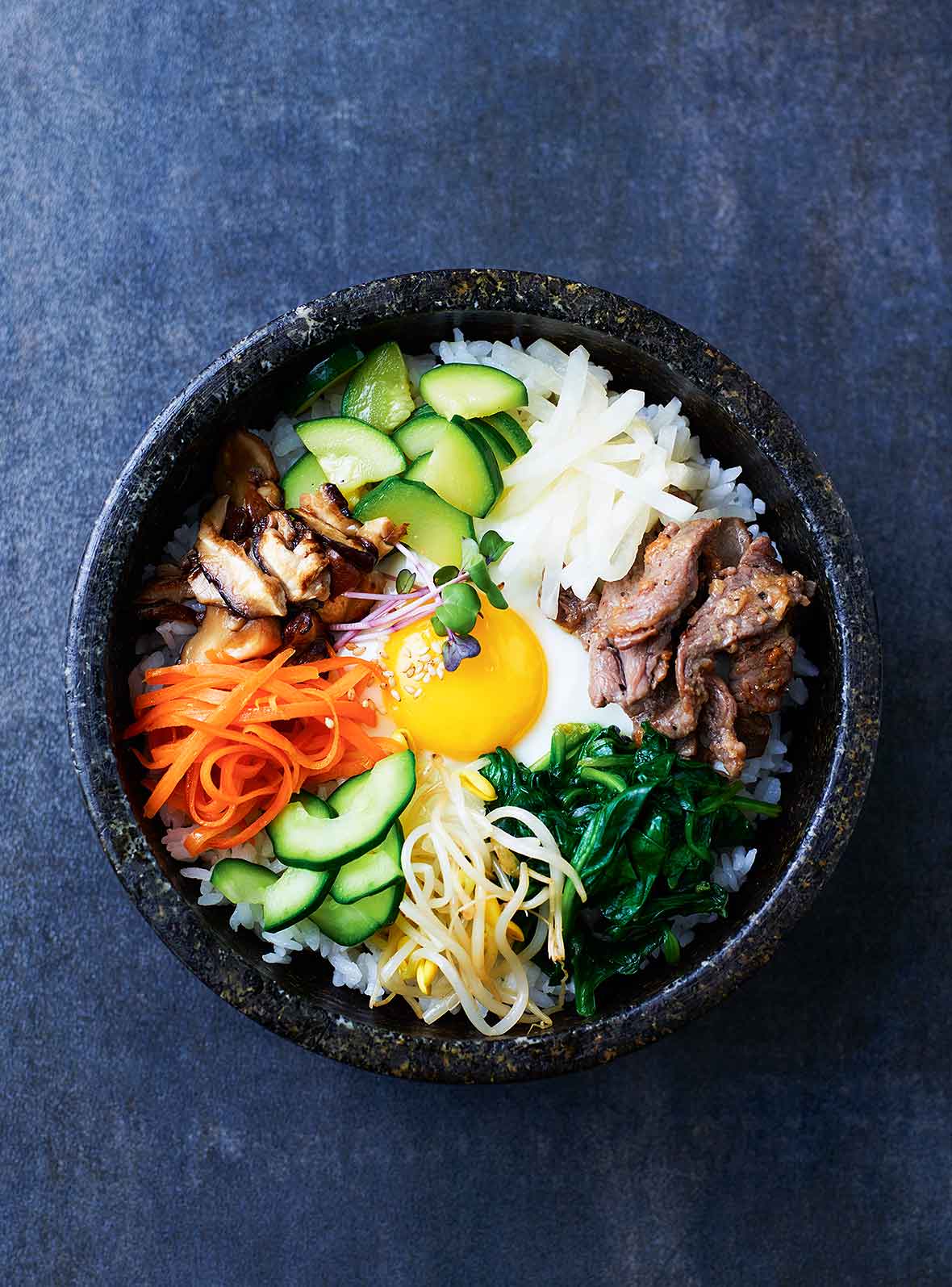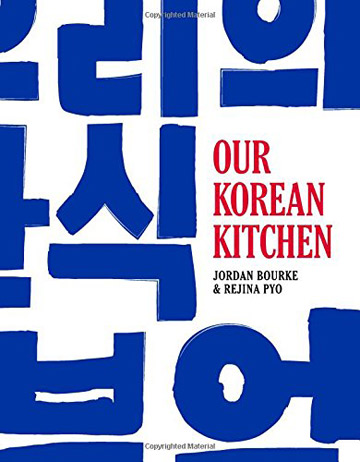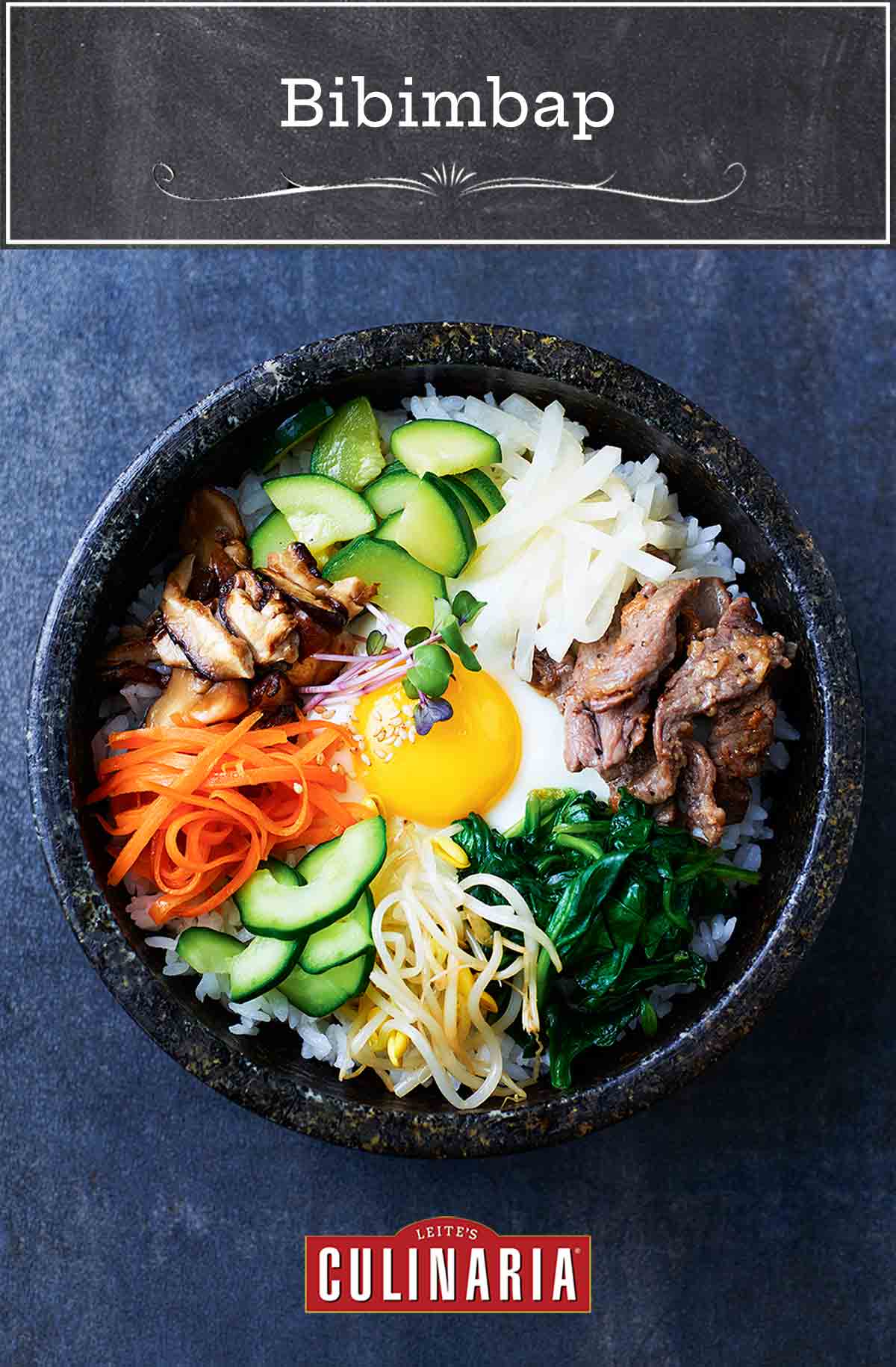
Bibimbap, in addition to being a hoot to pronounce, is also something of a beauty to behold thanks to its hypnotic jewel-like vegetables. Although don’t get too accustomed to its beauty. The moment you douse it with the smoky-sweet sauce and toss everything together, its aesthetic loveliness will be replaced by its gustatory magnificence. And we’re okay with that.
What is Bibimbap?
In Korea, bibimbap is a pretty traditional meal that consists of a bowl of white rice (bap) served with sides of sautéed vegetables, kimchi, gochujang sauce, sliced meat, soy sauce, and many other additions. Served hot, it’s stirred together thoroughly (bibim) before eating.

Bibimbap
Ingredients
For the gochujang sauce
- 3 tablespoons store-bought or homemade gochujang chile paste
- 1 tablespoon soy sauce
- 1 tablespoon roasted (dark) sesame seed oil
- 2 garlic cloves, crushed
- 1 tablespoon sugar or maple syrup
For the marinated beef
- 10 ounces beef sirloin
- 2 1/2 tablespoons soy sauce
- 2 teaspoons roasted (dark) sesame seed oil
- 3 garlic cloves, crushed
- 3 scallions, very finely chopped
- 1/2 teaspoon ground black pepper
For the bibimbap
- 2 cups short-grain white rice
- 5 ounces carrots, cut into very thin ribbons using a vegetable peeler
- 2/3 pound zucchini, quartered lengthwise and thinly sliced
- 5 ounces cucumber, halved lengthwise, seeded and thinly sliced
- 5 ounces daikon radish, peeled and cut into thin strips
- 5 ounces bean sprouts
- Roasted (dark) sesame seed oil, to season
- Soy sauce, to season
- Mild vegetable oil, for frying
- 7 ounces shiitake mushrooms, stemmed and sliced
- 10 ounces spinach
- 4 large eggs
- Toasted sesame seeds, to serve
- A few leaves of salad greens or watercress, to serve (optional)
Instructions
Make the gochujang sauce
- In a bowl, combine all the sauce ingredients and set aside.
Make the beef marinade
- Slice the beef very thinly—slightly less than 1/8-inch thick works well. (The beef is easier to slice if you first place it in the freezer for about 30 minutes to partially chill it.)
- In a bowl, mix together the soy sauce, sesame seed oil, garlic, scallions, and pepper. Add the sliced beef, cover, and set aside for 30 to 60 minutes.
Make the bibimbap components
- Cook the rice according to the package instructions. Keep warm.
- Fill a large saucepan with water and bring it to a rolling boil. One by one, blanch the carrots, zucchini, cucumber, and radish for 1 minute and the bean sprouts for 2 1/2 minutes. Use a slotted spoon or sieve to remove them from the water, and drain fully. Season each vegetable with 1/2 teaspoon roasted sesame seed oil and soy sauce each, keeping the vegetables separate at all times.
- Heat 1 tablespoon vegetable oil in a skillet over medium-high heat. Add the mushrooms and stir-fry until softened, 4 to 5 minutes. Dump the mushrooms in a bowl and season with 1/2 teaspoon each roasted sesame seed oil and soy sauce.
- Return the skillet to medium-high heat. Add the spinach and sprinkle with 2 teaspoons water. Cook for a few minutes, stirring constantly, until the spinach has wilted. Remove the spinach, squeeze out any excess water, and season with 1/2 teaspoon each roasted sesame seed oil and soy sauce. (In Korea, these vegetables are served at room temperature, so don’t worry about keeping them warm.)
- Return the skillet to medium-high heat, add the marinated beef and the marinade, and stir-fry until the sauce has reduced and the meat is cooked through, about 3 minutes, give or take depending on how thinly you sliced the beef. Move to a plate.
- Wipe out the skillet or use a clean pan and fry the eggs to your liking.
- Divvy the hot rice among 4 individual bowls. Place 1 egg in the center of the rice, then arrange the vegetables and meat around it. Sprinkle over some sesame seeds and salad greens or watercress, and serve with the gochujang sauce. (Advise guests to start with a couple of spoonfuls of the sauce and mix everything together well. Add more gochujang sauce to taste.)

Explore More with AI
Nutrition
Nutrition information is automatically calculated, so should only be used as an approximation.
Recipe Testers’ Reviews
I love everything about this bibimbap recipe. The marinated beef is so tasty with all the different veggies and the sauce has an addictive, slightly spicy, barbecue flavor. (I used sugar, but I could see maple syrup being equally or even better tasting. I had intended to use maple syrup, but there was none to be found when I went to make it.)
Another great thing about it is that it can be tailored to your personal tastes by adding or leaving off toppings of choice.
I love bibimbap, the Korean dish of mix-it-all-up dish of rice, meat, and vegetables, but I’ve never made it at home. I’m glad I finally did thanks to this recipe. It’s pretty well written with simple instructions and produces a delicious bowl of food that’s lovely to look at and even better to mix up and devour with the savory spicy gochujang sauce. It has a perfect mix of textures and colors and the best part is it can be endlessly customizable with all kinds of vegetables in various ratios to the rice. The best part is that the kids loved it, vegetables and all—well, minus the mushrooms for them.
This is not, however, a quick dish. It takes time to wash, chop, marinate, and cook all the vegetables separately. So plan accordingly but it’s worth the effort. The timing for blanching all the vegetables was perfect. Everything was tender but retained a good crispy texture without the rawness. I could not find shiitake mushrooms so I ended up with regular brown mushrooms, but the cooking time worked well. The beef should be sliced very thin for this. I got it sliced about 1/8-inch but thinner is probably better. It helps if you partially freeze the beef before slicing.
A lot of the work can be done ahead of time. I wanted to serve this for a midweek dinner so I had all the vegetables cut, blanched, and seasoned the night before. I stored them in separate containers and refrigerated them until about 2 hours before serving. So when we were ready to eat, they were at room temperature. This made 4 generous servings with some vegetables leftover.
Stock up on Korean gochujang sauce and transform your rice bowls! This bibimbap recipe is easy to follow and quick to make. It’s the perfect weekday dish or a unique meal for a weekend dinner party.
I found the sauce to have the perfect balance of umami and spice and loved the fresh veggies and fried egg added to the top. I found the prep moved along quickly. While the beef marinated, I cooked the rice and the veggies and prepared the sauce. While the beef cooked, I used a separate pan and fried the eggs.













Great recipe to base my own version off of.
Thanks, Victor. We’d love to hear about your version.
Thanks for sharing! I couldn’t find a few things so subbed what was available. Also, wasn’t brave enough to go hunting for Gochujang during the Covid-19 Crisis. K-Markets are far from where I live so used Nando’s medium Peri Peri Sauce x 4 Tbsp and tasted pretty good!
Widad, gorgeous! And a wise choice to stay put.
Wonderfully flavorful!
Thanks, Moore. We’re so pleased you enjoyed it.